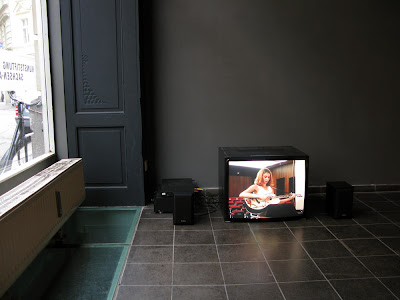
 http://www.emare.eu/move/en/index_en.html
http://www.emare.eu/move/en/index_en.htmlExhibition from 9th to 25th October in Halle (Saale), Germany
The exhibition .move presents 16 current works of 21 young and leading European media artists: video installations, interactive virtual environments, performances, and an Opera Digitale. The works were produced from 2008 to 2009 within the scope of the European Media Artists in Residence Exchange (EMARE) programme at the organisations Impakt (Netherlands), InterSpace (Bulgaria), VIVID (Great Britain) and Werkleitz (Germany). They will experience their German premiere in Halle. From October 9th to 11th the exhibition kick-starts with the artists discussing their works with international media art experts (respondents). The festival programme will be supplemented through presentations of students of the media art class of Burg Giebichenstein Halle. Nightly live acts and performances at the Riff Move Club are further components of .move.
The European scene meets the local network of galleries in Halle. Unique locations like the state's museum Stiftung Moritzburg, the galleries Raum HELLROT, dieschönestadt, archcouture, the format filmkunstverleih, the Intecta department store, and the Riff Club will host the new art works. The title .move conveys the concept of the exhibition, including the motion of the picture as well as the motion of the audience fostered by the artistic audio guides of Ralf Wendt and Bertram Weisshaar. Furthermore, many works of the exhibition live through the mobility of the visitor, whether it is at interactive installations or by participating in community projects.
Artistic interest in the moving image began, some might say, with Nam June Paik’s TV manipulations in the 1960s or, others opine, with Walter Ruttmann’s first abstract experimental film Opus 1, way back in the early 1920s; to say nothing of those experiments with moving images pioneered by the like of Eadweard Muybridge in the latter half of the nineteenth century.
And what visions are artists pursuing now, at the start of the twenty-first century? Why is the significance of the moving image in artistic production increasingly on the rise?
In his work, Kommunikologie, media theorist Vilém Flusser differentiates between the magic lantern era, the written word era and that of the technical image, in which we now find ourselves. Flusser understands by ‘technical image’ all kinds of technologically generated image, from photography and film through to traffic signs and pictograms. By illustrating concepts rather than depicting reality, these ‘codify’ the world. Easily misinterpreted, if not downright deceptive, they can distort people’s view of reality. According to Flusser, the meaning of, and approach to technical images must first be learned: ‘Either we live within impermeable walls [composed] of meaningless images or we use these images to build bridges across the world’1.
To build new bridges across the world is the very challenge that lies in using technologically generated images for artistic purposes. Sixteen new projects produced during the ‘European Media Artists in Residence Exchange’ programme (EMARE), fathom the inherent potential of different types of motion picture in a free, experimental manner. They were realized in the course of the last two years, in the framework of a two-month residency in Bulgaria, the UK, the Netherlands or Germany, courtesy of the European Media Art Network: InterSpace in Sofia, VIVID in Birmingham, Impakt in Utrecht and Werkleitz in Halle. The projects reflect their creators’ personal cultural background and often also that of the host country where they were produced. They are as heterogeneous as the diverse cultures, mentalities and languages found on the continent of Europe.
Helene Sommer, Dagmar Keller & Martin Wittwer, Theo Prodromidis and Shu Lea Cheang all address the impact of globalisation processes on Bulgaria’s culture and self-image, whereby the focus rests equally on political, ideological and urban mechanisms. Questions of national respectively individual identity are also peripheral themes in the work of Katarina Zdjelar and Ran Huang, although each takes a very different approach to putting the spotlight on intercultural encounters. While Karen Mirza & Brad Butler examine patterns of civic engagement and the appropriation of urban space in Halle, Ania Molska & Krzysztof Franaszek pursue a similar path in Utrecht. Raymond Taudin Chabot and Tereza Severová, on the other hand, intervene in the actual exhibition venue. And, finally, Nika Oblak & Primož Novak, Kurt D’Haeseleer, Thomas Köner, Paolo Cirio, Don Ritter, and Julio Soto & Scott Petill address cultural and medial phenomena, not infrequently with subversive humour. Visitors’ interaction with the exhibits is provoked on several occasions.
Thus, the exhibition title .move stands not only for the moving image so indispensable to each project but also for the recipient’s physical movement and his/her psychic agility in perceiving new and unfamiliar forms. .move invites visitors to take a walk around Halle, in the inspired company of audio-guides compiled by Ralf Wendt and Bertram Weisshaar, which open up access to the city’s urban spaces in an auditory-associative manner.
In an open forum, on the opening weekend of the Festival, the respondents – international media art experts – will discuss with the artists the various positions on show. They also had been invited by the organisers to write the catalogue texts on the artistic works. The respondent method, derived from the scientific field, will hopefully serve to spur and deepen discourse between the artists, the experts and the public.
Shu Lea Cheang, USA / France
Paolo Cirio, Italy
Kurt D'Haeseleer, Belgium
Ran Huang, China / UK
Dagmar Keller & Martin Wittwer,
Germany / CH
Thomas Köner, Germany
Karen Mirza & Brad Butler, UK
Anna Molska & Krzysztof Franaszek, Poland
Nika Oblak & Primož Novak, Slovenia
Theo Prodromidis, Greece / UK
Don Ritter, Canada / Germany
Tereza Severová, Tczech Republic
Helene Sommer, Norway
Julio Soto & Scott Petill, Spain / USA
Raymond Taudin Chabot, Netherlands
Katarina Zdjelar, Serbia / Netherlands














